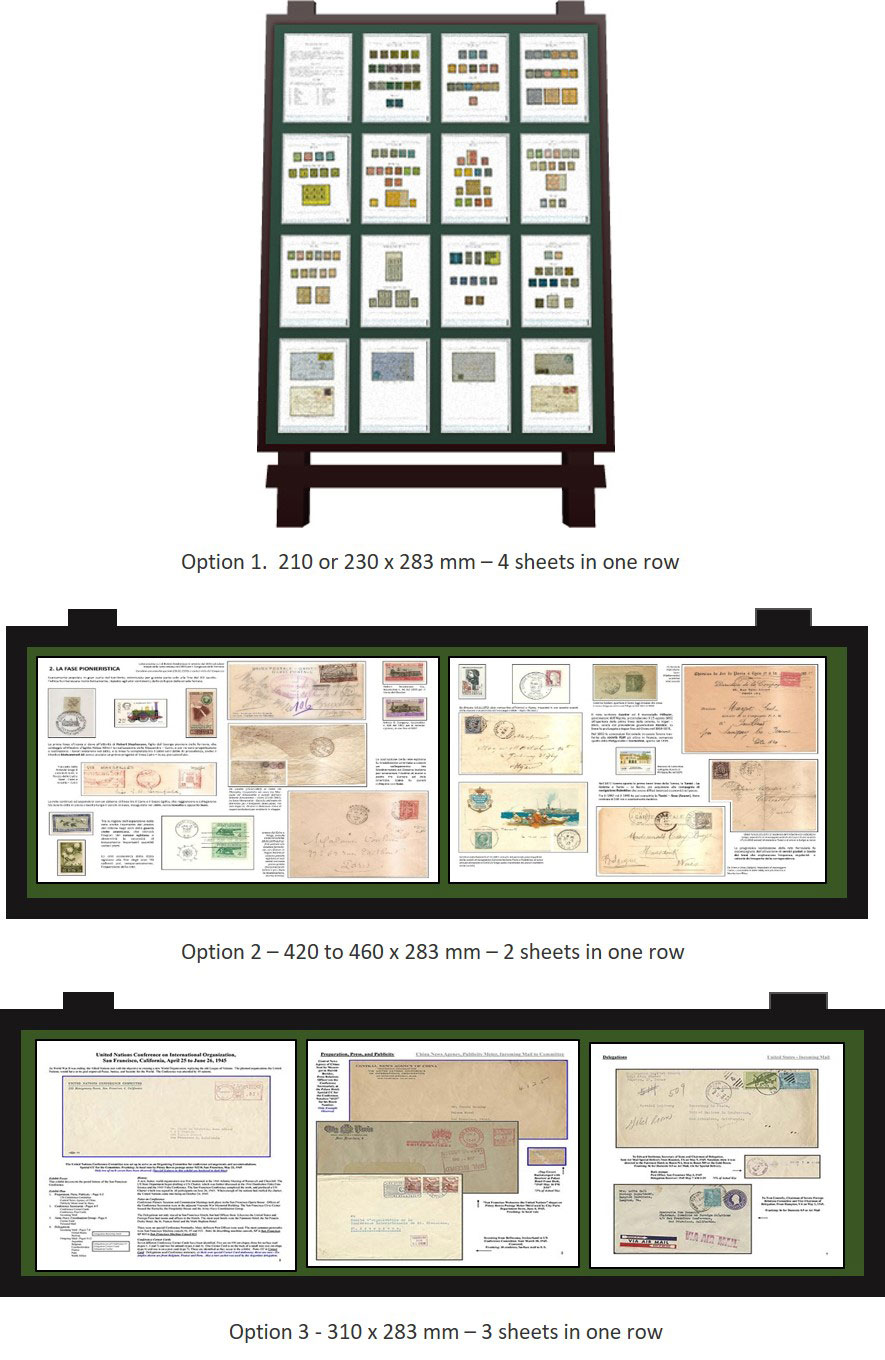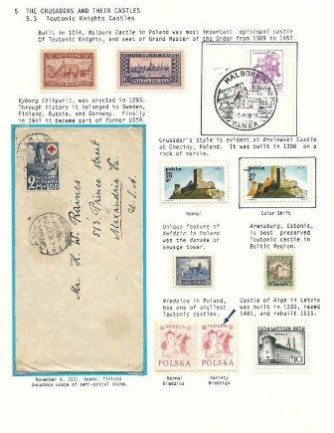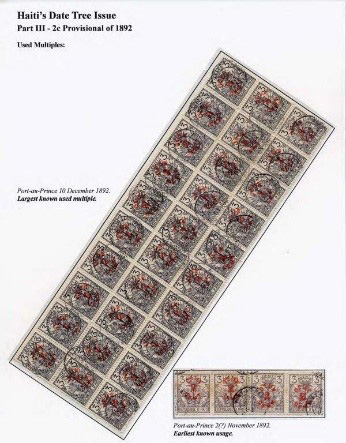Exhibiting – Display Sheets
We are often asked for advice on the best display sheet to use for exhibits. Display sheets come in different sizes, weights and colours. Each sheet is put into a lightweight transparent protector, with only one side open. The protector should not exceed the display sheet by more than 1 cm all round. Sheets without protectors will not be accepted into any exhibition.
Display Sheet Weight
Standard paper is about 80 gsm and is too flimsy for exhibiting. By the time you affix a cover to the page it will need the additional support that a heavier grade paper gives. Try affixing any cover/postcard to the top of a sheet of standard A4 paper and leave about 1cm of clear space above it. Now try standing it upright (as if it were in a frame). Then turn the page upside down – so that the cover is at the base of the sheet. Although the sheet of paper with the cover at the base is more stable the overall appearance aspect of an exhibit would look odd if covers were only at the bottom of each sheet.
It will cost a bit more, but it is worth acquiring a heavier weight paper. A heavier grade paper page will be better able to support the cover in the upper position. Up to 140 gsm can still fit into a computer printer.
Display Sheet Size
Some time ago it was only possible to exhibit on sheets that were 230 x 290 mm in size. Since the mid-90s, with the introduction of personal computers and various types of printers, exhibitors were given more freedom to decide how to prepare, organize and print their exhibits. This included the use of other sheet sizes.
Exhibitors can now choose from the three sets of FIP approved exhibit sheet sizes. It should be noted that these approved sizes include the protector that surround the sheet. See sheet dimension diagrams below.
A4 – 210 x 297 mm or 230 x 290 mm
A3 – 420 x 297 mm or 460 x 290 mm
Square – 310 x 290 mm

Even though the FIP has approved page heights of 29.7cm there are many exhibitions where the frames do not allow this height. We recommend that you should not use standard A4 (210 x 297) or A3 (420 x 297) as they are usually about 1 cm too tall to fit into frames. We recommend using sheets that do not exceed 283cm in height including the protectors. It is important that the height of exhibit does not exceed the frame height, or you may receive your pages back damaged.
The first option uses the smallest sheet. There will be 16 pages in one frame (4 rows of 4 pages). The second option is the largest format, where there are 8 pages in one frame (or 4 rows of 2 pages). The third option is the so-called square or “Damian Läge” format (because he was the first to use the format). This uses 12 almost square pages per frame (or 4 rows of 3 pages). Examples of these can be seen in the following frame layout options.

Which sheet size should I use?
Looking at exhibits in current exhibitions, I have noted that more than half of the exhibitors use the smaller size pages. If they choose to use larger pages, it is more common for them to use the largest size and not the square sheets.
Exhibition frames can take pages that are wider than standard A4 or A3. However, exhibitors often use the narrower pages. Presumably the choice is made because their existing home printer will easily print these pages. There are advantages to the exhibitor in using the widest of the small sheets, 230 x 283 mm. If you intend to exhibit often it is worthwhile reviewing the cost of a new printer to give yourself more flexibility.
It might be best for new exhibitors to start with option 1, the smaller size pages. Unless you are an experienced exhibitor you will find the smaller sheets simpler to design and the text will flow naturally from left to right, top to bottom. They are also easier to manage when there is a need to modify or rework. However, there are at least two occasions when new exhibitors need to consider using larger pages: when displaying very large material and when they want to show several items on a single sheet that simply do not fit onto the smaller page.
An exhibitor should never cut, shorten or fold covers. Mounting long covers at an angle or vertically should be avoided. It is relatively easy to place them upright or diagonally so that they fit on the page, but they don’t look right like that (see figures 1 and 2). You do not read an addressed cover leaning heavily to one side! With larger pages you can mount larger items horizontally, so your material can be seen easily. In Revenue and Open exhibits, due to the often large or unorthodox sizes of non-philatelic materials, mounting on the larger size sheets can often be advantageous to achieve a more attractive presentation.

Figure 1: Example of vertical mounting

Figure 2: Example of diagonal mounting
The larger sheets enable you to show more items on each page and make it possible to show large-sized philatelic items such as parcel post, postal stationery, telegrams, original artwork. Two smaller sheets have four margins, but one large sheet has only two margins. With fewer margins you can use the expanded centre area of the page.
There are other considerations. With the largest sheet you only have half the number of pages and you may be limited in the number subtitles that you are able to use. However, in general, a larger page allows you to be more creative when writing up the text.
The largest sheet size is not easy to handle or to layout the material and text correctly. Some exhibitors use large sheets but still divide the page into two halves, sometimes even separated by a line in the middle of the page. This is not liked as it is poor treatment and difficult for the reader to follow. If you use the large sheets you need to manage to fill the whole page and take care of the fact that you should be able to read from left to right and from top to bottom.
The square sheet is gaining in popularity. It has the advantages of the additional width and can accommodate almost all the oversized items. Some classes such as postal history, postal stationary aerophilately, astrophilately and maximaphily have material that are mainly envelopes or cards. The danger of using the smaller sheets is that usually only two items can be placed on any sheet and the exhibitor can fall into a repetitive “tram track” layout, each page has two covers one on top of the other, or inappropriate overlapping. The square sheet overcomes these issues as the extra width encourages offset envelopes and allows more material per page. It is also easier to design than the larger pages and this can lead to improved treatment.
It is possible to use a mixture of sheet sizes in one exhibit. You do need to consider the overall balance or appearance of a random double page in an exhibit. You also need to be careful to plan the flow of your exhibit to take the layout of the frame into account. You must make sure that a double page will fit where you want it. You can have a double page at the start or end of a row with two small pages on either side, or have one small page, one large page and one small page in one row.
When you have decided on the paper to use you should buy enough paper to see you through the life of the exhibit. It does not look good if newly mounted sheets are different to the original.
Display Sheet Colour
Display pages should be plain with no lines. Many exhibitors use white pages. Although white is a fairly harsh colour it is perfectly acceptable. Off-white, cream and pastel colours are not as harsh in appearance still give a good contrast to the material shown thereon.
You can buy paper in any number of strong colours and fancy pages with arty surrounds and headings. This may be suitable for party invitations but not for exhibits because it detracts from the more important material on it. In effect you will more likely be penalised by judges if you use garish coloured paper because it will be difficult to focus upon what you are saying. Black pages are not allowed.
Obviously, it is up to the exhibitor to choose his or her exhibition pages carefully, but please bear in mind that there are some other aspects that need to be considered before finalising one’s choice.
Sheet Protectors
Transparent protectors should be used for each page. Ensure they are made of the correct material and will not damage the pages and material over time. Remember if the protectors are too large, they may not fit the frames and could be damaged or your pages may not be exhibited.
The word “archival” has become one of those terms used to sell products and make consumers feel safe. But with no regulations to control or define what constitutes an archival product, consumers must educate themselves. You should look for plastic that is polyester, polyethylene or polypropylene. Be wary of ‘vinyl’ or ‘polyvinyl chloride’ or ‘PVC’ as it is not safe and is highly reactive. This reaction will, over time, cause permanent damage. For better quality and protection, use Mylar sheet protectors (also called polyester).
Pages should be numbered. This is best done with a small sticky label on the back of the protector.
Corner Mounts (for attaching covers to exhibit pages)
Self-adhesive clear mounting corners provide a safe, time saving method of securing covers and similar material. Choose corner mounts where the corner is clear so that they become almost invisible. The choice of size of the corner mount depends on the size of the item, large items need larger mounts. It is very important that all items are held securely on the page, an item that has fallen will detract from presentation. Like paper and protectors, the corners should be acid-free.
APF Store:
The APF Store has display pages, sheet protectors and archival quality photo corners for sale. They can be viewed at the following website: https://apf.org.au/store/. Orders may be placed by sending the downloadable order form.
Our APF store Manager Mike Kovaleff¸ can be contacted by EMAIL , by telephone on 08 8552 1983 or by mail at PO Box 506 Victor Harbor SA 5211. Orders are processed on Mondays and Thursdays.
| Display Pages in packs of 50 – 140 GSM - low acid bleached |
||||||
|---|---|---|---|---|---|---|
| 283x210mm | 283x216mm | 283x230mm | 283x310mm | 283x454mm | ||
| Off-White | X | X | X | X | X | |
| Plain White | X | X | X | X | X | |
| Feint-grille | X | X | ||||
| SHEET PROTECTORS IN PACKS OF 50 - TOP OPEN | ||||||
| 285x225mm | 285x240mm | 285x320mm | 285x420mm | 285x457mm | 285x465mm | |
| Polypropylene 60 micron clear | X | X | X | X | X | X |
| Mylar | X | X | X | x | X | |
| ACID FREE PHOTO CORNERS | ||||||
| 16mm across | 19mm across | 35mm across | ||||
| Polypropylene | X | X | ||||
| Mylar | X | X | ||||
Sheet Dimension Diagrams
Frame Layout Options
